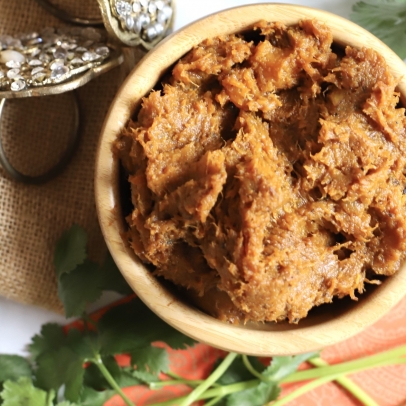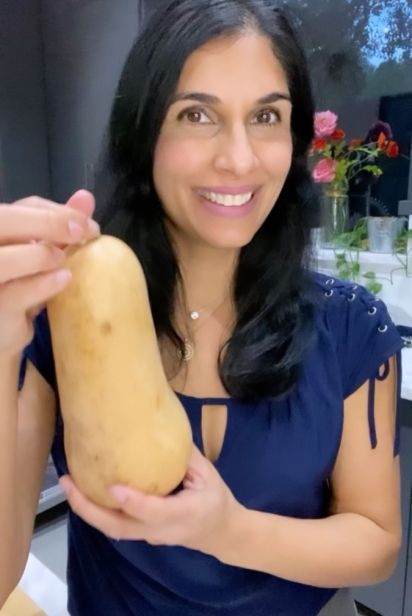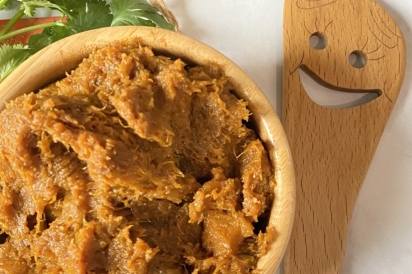Bring On the Butternut
Spotlight On Local
Let's go beyond bright orange pumpkins this fall and bring home a barrel of beautiful butternut squash. Not just to adorn your front stoop or to make cute ghosts for Halloween by painting them white and drawing on eyes, but also to add to the fruit bowl on your kitchen countertop — and mainly, to savor its sweet flavor when cooked Indian style.
The funny thing about this is that butternut squash is not typically found in India or in Indian cuisine. It is a fairly modern variety of winter squash developed in the United States in 1944. Even though squash has had significant prominence in the cuisines and cultures of Native Americans for hundreds of years, butternut squash was not amongst their annual crops. Legend has it this cultivar was developed by Charles Legget, a gentleman from Massachusetts, by crossing gooseneck squashes with other varieties. Legget named this new strain "butternut squash" since he said it was "smooth as butter and sweet as a nut."
So how did Indian style become one of the most delicious and easiest ways to enjoy butternut squash? Growing up, my mom would make a traditional savory Indian dish called petha from an Indian pumpkin that is similar to calabaza (a winter squash we commonly find here that is also known as West Indian pumpkin). My mom usually buys Indian pumpkin at local Indian grocery stores, where it is often cut in half or quartered so you can see the beautiful bright orange flesh.
When I was writing my second cookbook, which highlights Indian fruit and vegetable recipes, I wanted to include some produce commonly found here that would be enjoyable when cooked Indian style. So, I asked my mom how to cook butternut squash Indian style. She suggested we make it like she cooks Indian pumpkin.
We tried it out. I vividly remember the sweet and spicy burst of flavor enhanced by tempered cumin seeds. I immediately knew this dish was a winner, and I liked it more than the Indian squash my mom makes because of the sweet notes. I named my dish "Sweet and Spicy Butternut Squash Mash." It has become one of the most popular recipes in my book Healthy Indian Vegetarian Cooking. I haven’t found one person, ranging from babies to adults, that has not liked this recipe, and I am confident this will be the new way you’ll enjoy winter squash this season!
CHOOSING AND PREPARING BUTTERNUT SQUASH
Butternut squash, which can be found at area grocery stores and farmers markets, have thick necks with a rounded bottom. They are smooth on the outside with a cream-colored exterior. Look for firm ones with matte rather than glossy skin, which indicate the squash was picked too early and will not be sweet. These squashes keep for over a month at room temperature in your pantry or fruit bowl.
Now that you’ve selected your squash, the most arduous step in this recipe is peeling and chopping it — the rest is a breeze. You can peel it with a regular vegetable peeler, though I have a wider, sharper bladed peeler specifically for butternut squash that glides the skin right off with hardly any effort. (Or you may prefer to buy it already peeled and chopped at your grocery store.)
Once it’s been chopped, this beautifully firm, orange winter squash cooks into a delicious, healthy and flavorful mash. Just cook it in a pan on your stovetop with olive oil and a few spices, cumin seeds being the star. Serve as a yummy side dish, or stuff it between American dinner rolls to create a tasty squash slider no one will say no to. This holiday season, swap out the sweet potato casserole with my unique Indian squash dish, and everyone will be extra thankful!
TIPS FOR ENJOYING OTHER WINTER SQUASHES
Before I leave you with my recipe, let's give a moment to some other common winter squashes, including the ubiquitous orange pumpkin. Winter squashes naturally mature in autumn and have a hard shell or tough skin that is usually cut or peeled off. The squash can also be cut in half or baked full, and the flesh can then be scooped out of the tough exterior. This year, instead of using canned pumpkin purée to make my family's favorite pumpkin bread, I am going to try baking a whole pumpkin in my oven and then scooping out the soft flesh to make the bread. I’ll mix nuts and dark chocolate chips into the batter and enjoy this scrumptious treat as a snack with morning coffee or afternoon tea.
Acorn squash is another cute winter squash that can be enjoyed savory or sweet. It is quite easy to bake right in your toaster oven. Slice it down lengthwise, scoop out the seeds, lay it on foil and drizzle with olive oil, roasted ground cumin, salt and black pepper, or, for a sweet version, with honey, brown sugar and cinnamon. Bake at 400 degrees for about 60 minutes or until tender.
Spaghetti squash is another winter squash that has firm flesh when raw, but when cooked the flesh turns into strands and can be served as a healthy substitute for spaghetti or other pasta.
Calabaza is very similar to the traditional Indian squash that inspired me to make this butternut squash recipe. It can be cooked the same way as I make my butternut squash mash.








